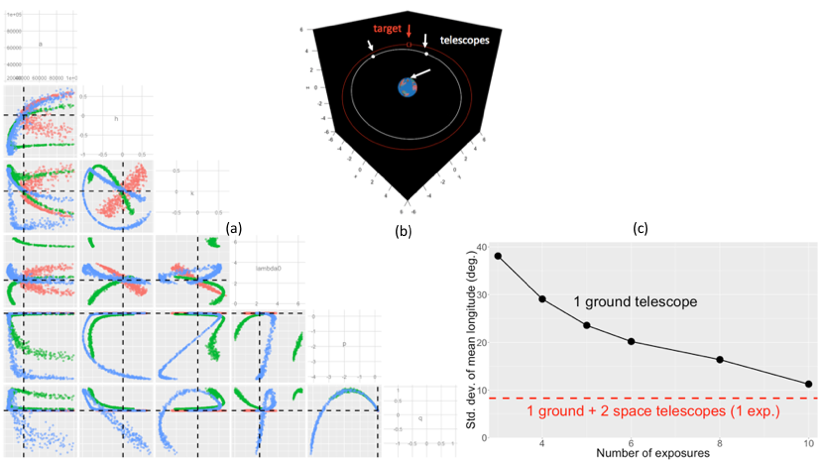Michael Schneider | 16-ERD-013
Overview
We developed a new method to analyze astronomical and space surveillance imaging data to characterize sources and constrain physics models of dark energy. Our approach relies on numerical forward simulation of images, including source properties (e.g., brightness, morphology, and spectral features), observing conditions (e.g., atmosphere turbulence and telescope image aberrations), and detector response. We embed these simulations into a Monte Carlo statistical framework to characterize noise distributions and propagate maximal information about sources in compressed form. Because our statistical characterization of images retains all statistical information, we are able to optimally combine information from multiple images to derive new insights that are often impossible with any single observation.
Background and Research Objectives
Traditional astronomical image analysis relies on point estimators of source properties extracted into a "catalog" for downstream processing. Such point estimators invariably become biased and sub-optimal as various systematic errors become important and as the signal-to-noise ratio of the measurements decreases. With a statistically sampled forward model of the sensor pixel data, we are less prone to biased inferences and can regulate the measurements with arbitrarily low signal-to-noise. With traditional source catalogs (which effectively discard most statistical information about the image at the outset) the only option for combining images is "stacking," during which a median or similar filtering operation is applied. This is an intrinsically lossy numerical operation leading to sub-optimal inferences of the observed source properties. Using statistical "importance sampling," however, we can combine the information from multiple images of a single source and/or related sources without loss of information.
Determining the orbits of moving objects from optical telescopes entails many challenges driven by gaps in data exploitation. These gaps include
- low signal-to-noise detections that are discarded,
- inaccurate error propagation that leads to spurious correlations or predictions,
- data fusion during the late stages of processing that leads to inconsistencies between different inputs, and
- data processing architectures that provide significant delays in analysis.
New data processing approaches have been motivated by closing these gaps to use more of the data of all qualities and to propagate uncertainties for more accurate results and more flexible analysis workflows (see figure).
We characterized orbits of moving objects with Bayesian forward models, yielding Monte Carlo samples from the joint posterior probability of six Keplerian orbit parameters. ( a ) Different colors show the posterior orbit inferences from different telescopes looking at the same object. The colored clouds are distinct because of the different geometric locations of the telescopes. ( b ) A schematic of the telescope and target locations. Two simulated telescopes are located in space, while a third is located on the ground. All take observations simultaneously, which are fused by Monte Carlo importance sampling given the individual sensor results in panel a . ( c ) A measure of in-track position uncertainty is compared as a function of time for a single ground-based telescope ( black line ) and the combination of one ground and two space telescopes as shown in panel b ( red line ). The geometric diversity of ground and space platforms allows rapid reduction of uncertainty in the position of the target relative to a single telescope.
Impact on Mission
The technologies developed in this project have had immediate impacts on remote sensing applications, such as space surveillance and nonproliferation monitoring. Results have already been incorporated into briefings for programmatic customers and external customers in the national security domain. We demonstrated new methods of data exploitation that can be applied to a wide variety of programs where data volumes are growing. This led to externally sponsored work for our project team members. Internal to Laboratory, the results of this project led to significant contributions from the astronomy team to a new institution-wide Data Science Institute.
Conclusion
The astronomical and remote sensing communities are in the midst of rapid technological change as sensors become commoditized. Data exploitation is the key focus for future advances. This research has established a path forward for optimal, sensitive, high-cadence, or distributed sensing applications. We are engaged in transferring these methods to upcoming astronomical sky surveys led by DOE and NASA, with support from each agencies’ relevant program offices.
Publications and Presentations
Dawson, W. A. and M. D. Schneider. 2016. "Synthesis of Disparate Optical Imaging Data for Space Domain Awareness." Advanced Maui Optical and Space Surveillance Conference, Wailea, HI, September 2016. LLNL-CONF-703178 and LLNL-PRES-703026.
Dawson, W. A., M. D. Schneider, and C. Kamath. 2016. "Blind Detection of Ultra-faint Streaks with a Maximum Likelihood Method." Advanced Maui Optical and Space Surveillance Conference, Wailea, HI, September 2016. LLNL-CONF-703048.
Schneider, M. D. 2016. "Generalized Multiple Importance Sampling for Source Characterization in Multi-Epoch Imaging." Center for Advanced Signal and Image Sciences (CASIS) workshop, Livermore, CA, May 2016. LLNL-PRES-691561.
Schneider, M. D., et al. 2017. "Probabilistic Cosmological Mass Mapping from Weak Lensing Shear." The Astrophysical Journal , 839 (1). April 2017. doi: 10.3847/1538-4357/839/1/25. LLNL-JRNL-697380.






